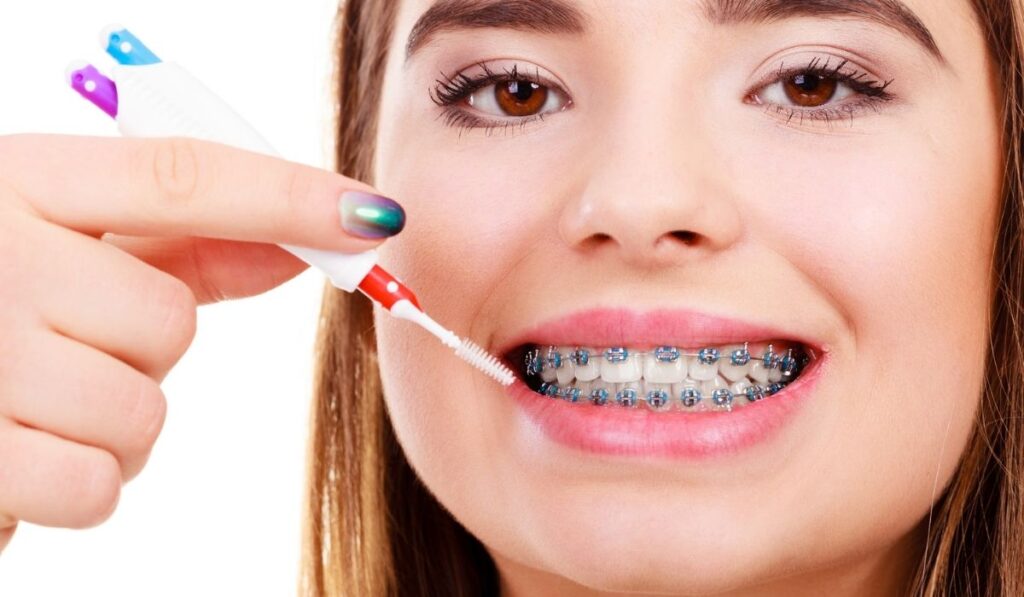Braces apply pressure to the teeth over time to gradually move them into the desired position. This is done with brackets that are attached to the teeth, connected by wires, and adjusted periodically to maintain the right amount of pressure. But can braces be used to fix gaps in the teeth?
Braces can help close gaps in the teeth over time, but there may be instances where the gaps return after treatment has been completed. To prevent gaps from returning, it’s important to wear a retainer as directed, maintain good oral hygiene, and visit your dentist regularly for check-ups.
Different braces can be more effective at treating gaps in the teeth; a dentist or orthodontist will determine the best type of braces for each individual case. Let’s take a look at what causes gaps in the teeth, how braces can help close those gaps, and how to maintain the results of treatment with braces.
What Causes Gaps in Teeth?

Many different factors can contribute to gaps in the teeth; some are genetic, and others are due to poor oral hygiene. Some common causes of gaps in the teeth include:
- Natural skeletal development: The size and shape of your teeth are determined by the bones in your jaw. If the bones in your jaw are not properly developed, it can cause gaps to form between your teeth.
- Missing teeth: If you have a missing tooth or teeth, it can cause the surrounding teeth to shift and gaps to form. Missing teeth can either be caused by trauma, such as an injury or tooth decay.
- Thumb-sucking: If you sucked your thumb as a child, it could cause gaps to form between your teeth when the permanent teeth come in. Thumb-sucking can also cause other structural issues with your teeth, such as an overbite or underbite.
- Small teeth: If you have small teeth, it can cause gaps to form when your permanent teeth come in. Gaps become wider when little teeth are matched with a lengthy jawbone.
- Medical conditions: Gaps in the teeth can also be caused by certain medical conditions, such as Ehlers-Danlos syndrome and cleft palate.
The most apparent sign of teeth gaps is, of course, visible spaces between your teeth. But other signs might not be as noticeable at first. These include:
- Bad bite: If your teeth don’t come together properly when you bite down, it could be a sign that you have gaps in your teeth.
- Difficulty chewing: If you have trouble chewing or your teeth feel misaligned, it could signify gaps in your teeth.
- Mouth breathing: If you mouth breathe, it can cause the muscles in your face to develop differently and lead to gaps in the teeth.
- Speech issues: If you have chronic lisps or other speech problems, it could signify that your teeth are not aligned together properly.
While gaps in the teeth are usually just a cosmetic concern, they can lead to other problems in certain cases. If you have gaps in your teeth, you may be at risk for:
- Tooth decay: When there are spaces between the teeth, it’s easier for plaque and bacteria to build up. This can lead to cavities and tooth decay.
- Gum disease: If you have gum disease, it can cause the gums to pull away from the teeth and form pockets. These pockets can easily become infected and lead to more severe issues.
- Injury: If you have gaps in your front teeth, you may be at risk of chipping or breaking your teeth if you fall or suffer an injury to the mouth.
- Misalignment: If you have gaps in your teeth, it can also cause misalignment and make it harder to chew properly. This can lead to jaw pain and joint issues over time.
Do All Types of Braces Close Gaps?
There are different types of braces available, and each type can be effective in closing gaps in the teeth. Metal braces are one popular option — they consist of brackets and wires that help to shift the teeth into place over time gently.
These braces are often recommended for more serious orthodontic issues, such as severe gaps in the teeth.
Another option for closing gaps in the teeth is Invisalign, which uses a series of clear plastic aligners to gently move the teeth into place. These aligners are virtually invisible, so they are popular for adults who prefer not to wear traditional braces.
Elastic bands are often used in conjunction with metal braces to help close gaps in the teeth. These bands are attached to the brackets and work by putting pressure on the teeth to help move them into place.
Can Gaps Close Naturally?
While some gaps in the teeth may close on their own over time, most will not. This is because the alignment of the teeth is determined by the size and shape of the jawbone. Gaps in children, for example, may become less noticeable as the jawbone grows and changes shape.
The fraenum, or the piece of tissue that connects the inside of your lip to the gum, may also pull the front teeth together over time.
However, these natural processes usually only affect small gaps in the teeth and won’t close larger gaps. Once the jawbone has grown to its adult size, it will not change significantly. In most cases, gaps in the teeth will need to be treated if the goal is to close them completely.
Can Gaps Get Bigger Over Time or Come Back?
Gaps in the teeth can potentially get larger over time if they aren’t treated. This is because the alignment of the teeth is primarily determined by the shape and size of the jawbone, which does not change significantly once it has reached its adult size.
Therefore, any gaps in your teeth will likely stay the same or even increase over time if left unaddressed.
In addition, gaps treated with braces or other orthodontic treatments may become wider again if you don’t wear a retainer to keep your teeth in place. It’s important to occasionally visit a dentist even after your gaps have been treated to ensure that they remain closed.
How to Care for Braces

When wearing braces, it’s very important to take good care of your teeth and gums to reduce the risk of developing issues like tooth decay or gum disease. Some basic tips for properly caring for your teeth while wearing braces include:
- Brush your teeth several times a day using a soft-bristled toothbrush (on Amazon), preferably after meals. Be sure to brush all surfaces of your teeth, including the areas around the brackets and wires. Clean your teeth and trays (if you have Invisalign) between meals.
- Floss gently between your teeth every day. You may want to use a floss threader or a Waterpik flosser (on Amazon) in order to properly reach all areas of your mouth.
- Avoid hard and chewy foods that can damage the brackets and wires.
- Avoid foods and drinks that can cause staining or damage your braces, such as acidic fruits and soda.
- Wearing a mouthguard when playing sports or participating in other activities could put your braces at risk of being damaged.
- Visit your dentist regularly for checkups and cleanings. This will help to ensure that your teeth stay healthy during and after treatment with braces.
- If your feel unusual discomfort in your mouth or notice any unusual changes in your teeth or gums, don’t try to adjust the braces yourself. Instead, see your dentist right away to prevent potential problems or complications.


